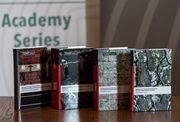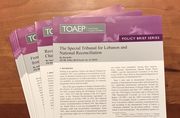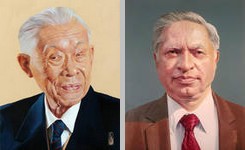Table of contents:
P.12. Evidence of intention inferred from words or deeds of the perpetrator prior to killing.
P.12.1. Evidence of declarations or songs prior to killing.
P.12.2. Evidence of threats prior to killing.
P.13. Evidence of a plan or organisation to kill.
P.13.1. Evidence of plans to kill.
P.13.2. Evidence of orders or instructions.
P.13.3. Evidence of the large and organised nature of the killings.
P.13.4. Evidence of the systematic and consistent character of the killings.
P.13.5. Evidence of knowledge that people were to be killed.
P.14. Evidence of intention inferred from the nature of violence used against the victims.
P.14.1. Evidence of brutality of the perpetrator's act.
P.14.2. Evidence of use of firearms against unarmed persons.
P.15. Evidence of intention inferred from words or deeds of the perpetrator after the killing.
Element:
According to the Semanza Trial Chamber:
"In order to be held criminally liable for genocide by killing members of a group, in addition to showing that an accused possessed an intent to destroy the group as such, in whole or in part, the Prosecutor must show the following elements: (1) the perpetrator intentionally killed one or more members of the group, without the necessity of premeditation; and (2) such victim or victims belonged to the targeted ethnical, racial, national, or religious group." "[1]
The Kajelijeli Trial Chamber said:
"Given that the element of mens rea in the killing has been addressed in the special intent for genocide, there is no requirement to prove a further element of premeditation in the killing."[2]
P.12. Evidence of intention inferred from words or deeds of the perpetrator prior to killing.
P.12.1. Evidence of declarations or songs prior to killing.
P.12.2. Evidence of threats prior to killing.
P.13. Evidence of a plan or organisation to kill.
According to the Gatete Trial Chamber:
"[t]he large-scale massacre at Kiziguro parish can only be described as a highly organised operation." It held that the accused participated in several ways in the conduct of this operation and that "he shared the common purpose of killing Tutsis at Kiziguro parish based on his presence during the operation, and on his express instructions to kill Tutsis there."[3]
The Nizeyimana Trial Chamber stated:
"In the Chamber's view, the open and notorious manner in which Tutsis were being targeted at these roadblocks, which were only a short distance apart, cannot reasonably be understood as coincidence."[4]
P.13.1. Evidence of plans to kill.
P.13.2. Evidence of orders or instructions.
According to the Nizeyimana Trial Chamber:
"Through his presence and orders at the roadblock, Nizeyimana substantially and significantly contributed to the killings of Remy Rwekaza and Beata Uwambaye, as well as the shooting of Witness ZAV. His position of authority among the relatively young ESO soldiers and his instructions to execute these Tutsis played a decisive role in these crimes. Indeed, as it relates to the incident of 21 April 1994, Nizeyimana's contribution of stopping Rwekaza and Witness ZAV after they were allowed through the roadblock, returning them to the barrier and then ordering their execution was a necessary condition to the ensuing murder and assault committed by the ESO soldiers."[5]
P.13.3. Evidence of the large and organised nature of the killings.
P.13.4. Evidence of the systematic and consistent character of the killings.
P.13.5. Evidence of knowledge that people were to be killed.
The Nizeyimana Trial Chamber said:
"The Chamber recalls its findings that around 18 April 1994, Nizeyimana ordered the removal of the Ruhutinyanya family, which included Tutsis, knowing that the implementation of this order would lead to the slaughter of the Ruhutinyanya family. [...] The Chamber considers that Nizeyimana's orders to return the family to the location from which they were first retrieved amounted to significant and substantial contributions to their deaths. In light of Nizeyimana's awareness that the implementation of these instructions would lead to the killing of this family, the only reasonable conclusion is that he too possessed genocidal intent. The Chamber also finds that Nizeyimana was aware of the genocidal intent held by the principal perpetrators."[6]
P.14. Evidence of intention inferred from the nature of violence used against the victims.
According to the Nizeyimana Trial Chamber:
"Given the nature of the attack, the Chamber finds that the assailants intentionally, killed members of the Tutsi ethnic group. In light of the high density of Tutsis among the displaced persons and the fact that they had gathered there largely as a result of attacks on Tutsis in neighbouring communes, the Chamber has no doubt that the assailants, including the ESO soldiers who participated in the attack, possessed genocidal intent."[7]
P.14.1. Evidence of brutality of the perpetrator's act.
P.14.2. Evidence of use of firearms against unarmed persons.
P.15. Evidence of intention inferred from words or deeds of the perpetrator after the killing.
Footnotes:
[1] ICTR, Prosecutor v. Semanza, "Judgement", ICTR-97-20-T, 15 May 2003, para. 319.
[2] ICTR, Prosecutor v. Kajelijeli, "Appeal Judgement", ICTR-98-44-A, 1 December 2003, para. 813.
[3] ICTR, Prosecutor v. Gatete, "Judgement", ICTR-2000-61-T, 31 March 2011, para. 597-600.
[4] ICTR, Prosecutor v. Nizeyimana, "Judgement and Sentence", ICTR-2000-55C-T, 19 June 2012, para. 1533.
[5] ICTR, Prosecutor v. Nizeyimana, "Judgement and Sentence", ICTR-2000-55C-T, 19 June 2012, para. 1520.
[6] ICTR, Prosecutor v. Nizeyimana, "Judgement and Sentence", ICTR-2000-55C-T, 19 June 2012, para. 1494.
[7] ICTR, Prosecutor v. Nizeyimana, "Judgement and Sentence", ICTR-2000-55C-T, 19 June 2012, para. 1505.







